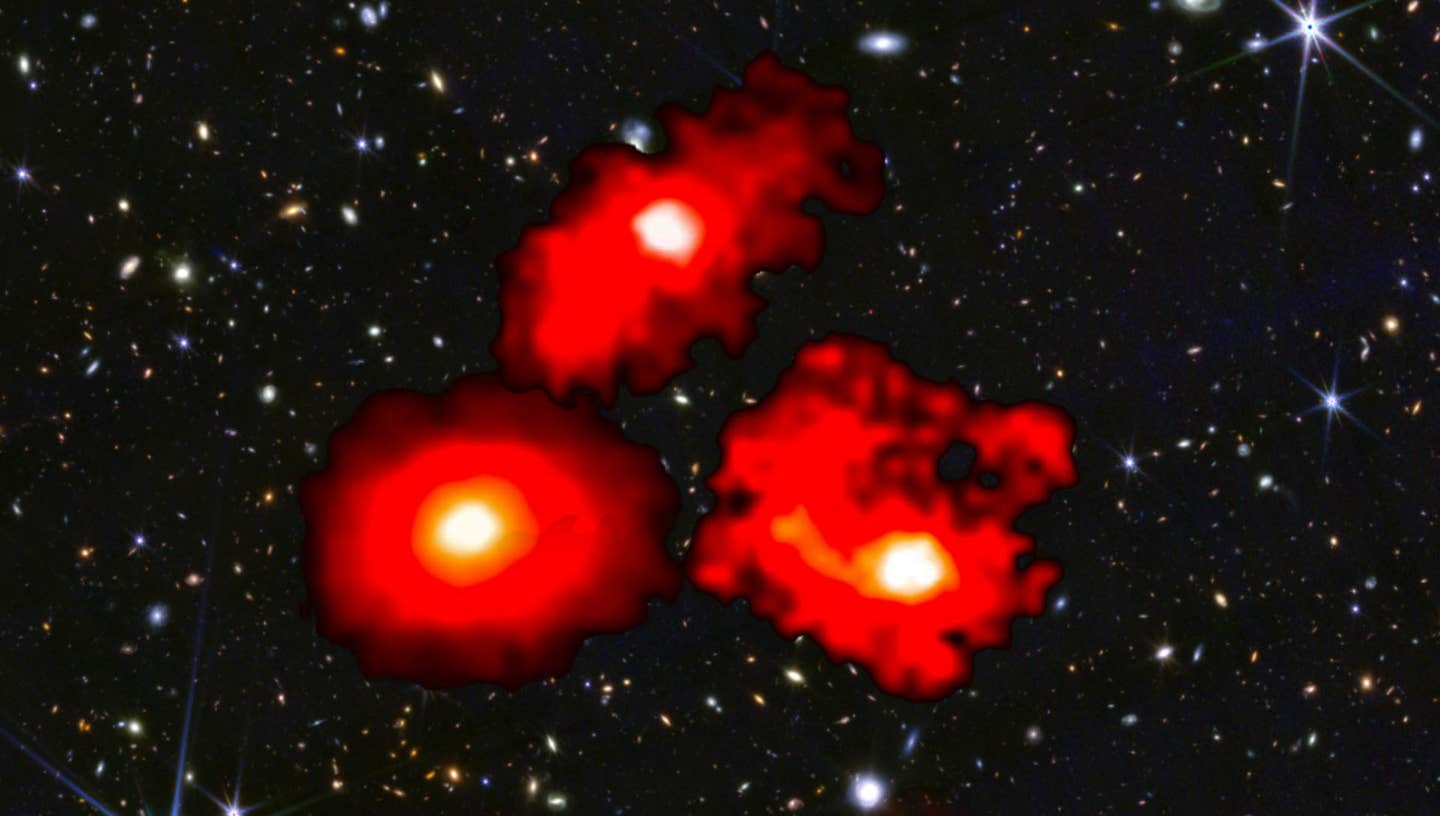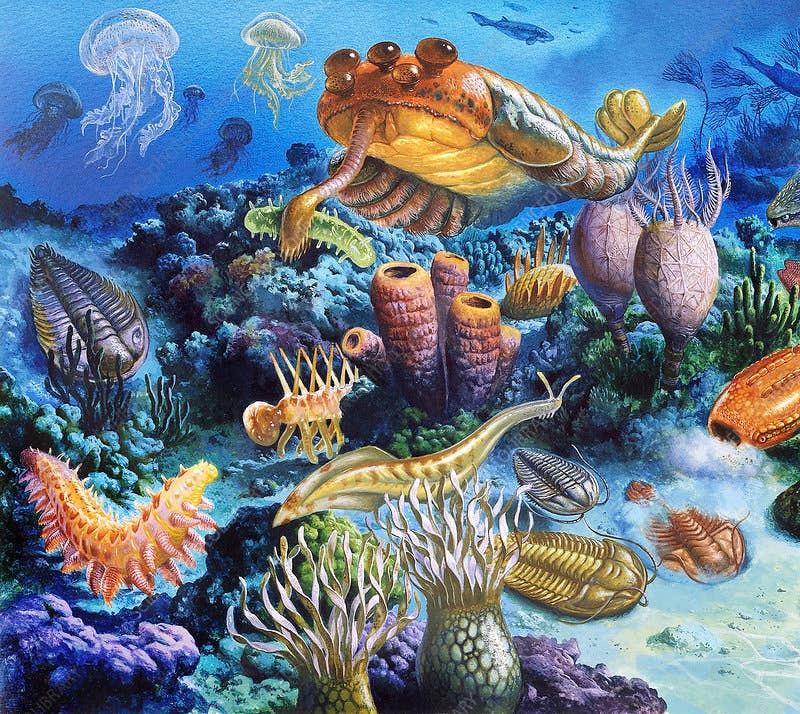Astronomers discover ultra-massive ‘Red Monster’ galaxies from the early Universe
WST unveils Red Monsters—ultra-massive galaxies that challenge our understanding of early cosmic history and galaxy formation.

JWST’s groundbreaking observations of the Red Monsters—massive galaxies formed within the Universe’s first billion years. (CREDIT: NASA / CSA / ESA / M. Xiao & P. A. Oesch, University of Geneva / G. Brammer, Niels Bohr Institute / Dawn JWST Archive)
Recent observations by the James Webb Space Telescope (JWST) have uncovered a trio of ultra-massive galaxies, each nearly as massive as the Milky Way, formed within the Universe's first billion years.
These findings challenge long-standing theories about galaxy formation and star production efficiency, reshaping our understanding of the cosmos’ infancy.
The discovery, published in Nature, stems from JWST’s FRESCO (Faint InfraRed Extragalactic Survey with NIRCam and Grism) program. Unlike traditional submillimeter surveys, FRESCO uses slitless spectroscopy, a technique that analyzes all light within a field of view. This allows astronomers to capture comprehensive data on distant galaxies without preselecting specific targets.
The international research team, led by the University of Geneva (UNIGE) and including Professor Stijn Wuyts of the University of Bath, systematically studied 36 massive, dust-obscured galaxies. These galaxies, hidden from optical surveys due to their high dust content, have spectroscopic redshifts between 5 and 9, corresponding to a time when the Universe was less than a billion years old.
The Red Monsters
Among the sample, three galaxies stood out for their extraordinary mass and rapid star formation. Dubbed the "Red Monsters" for their red hue in JWST images, these galaxies have stellar masses comparable to modern Milky Way galaxies. They form stars nearly twice as efficiently as other galaxies from the same epoch and far more efficiently than those observed in later cosmic history.
“Finding three such massive beasts among the sample poses a tantalizing puzzle,” said Wuyts. “These Red Monsters seem to have bypassed the usual rate-limiting processes that regulate star formation in galaxies.”
The efficient star formation observed in these galaxies is unprecedented. Typically, dark matter halos, which act as gravitational anchors, capture gas, leading to star formation.
Related Stories
However, only about 20% of this gas usually converts into stars. The Red Monsters defy this norm, with one galaxy converting up to 50% of its available baryons into stars, two to three times higher than the most efficient galaxies at later epochs.
A Game-Changer for Cosmology
JWST’s unparalleled sensitivity in the near-infrared spectrum has made this breakthrough possible. The telescope’s NIRCam/grism combination not only measures galaxy distances with high precision but also reveals their physical characteristics, including stellar mass and star formation rates.
“Our findings highlight the remarkable power of NIRCam/grism spectroscopy,” said Pascal Oesch, principal investigator of the observation program. “It allows us to trace galaxy growth over time, offering a clearer picture of how stellar mass accumulates throughout cosmic history.”
While these discoveries align with the standard ΛCDM cosmological model, they challenge existing galaxy formation theories. The presence of such massive galaxies so early in the Universe suggests that unique processes might have driven their rapid development.
The Role of Dusty Star-Forming Galaxies
Dusty star-forming galaxies (DSFGs), like the Red Monsters, play a critical role in understanding cosmic history. They account for up to 17% of the total cosmic star formation rate density at redshifts of 5 to 6. Until now, these galaxies were largely overlooked due to their optical invisibility.
By leveraging the deep 4-5 µm grism spectra from the FRESCO survey, researchers could probe key emission lines, including Hα+[NII] and [OIII]λλ4960,5008+Hβ. This provided crucial data for calculating accurate stellar masses and star formation rates.
“Our findings are reshaping our understanding of galaxy formation in the early Universe,” said Dr. Mengyuan Xiao, lead author and postdoctoral researcher at UNIGE. “The massive properties of these Red Monsters were hardly discernible before JWST.”
A New Era of Cosmic Exploration
The discovery of the Red Monsters marks a milestone in astronomy. These galaxies not only push the boundaries of current models but also hint at the existence of more such massive systems in the early Universe. Future observations with JWST and the Atacama Large Millimeter Array (ALMA) promise to expand the sample and deepen our understanding of early galaxy formation.
Dr. David Elbaz, a collaborator from CEA Paris-Saclay, emphasized the significance of these findings: “The Red Monsters offer a glimpse into a previously hidden population of galaxies. They are crucial for piecing together the early chapters of cosmic history.”
Professor Wuyts reflected on the implications of these discoveries: “Astronomy continually surprises us. JWST, in its early years, has already unveiled phenomena that challenge our understanding of the cosmos. It’s a thrilling time to be exploring the Universe.”
As research progresses, the Red Monsters and their counterparts will provide invaluable insights into the mechanisms that shaped the Universe’s earliest epochs. These findings not only enhance our knowledge of galaxy formation but also underscore the transformative power of modern astronomical tools like JWST.
Note: Materials provided above by The Brighter Side of News. Content may be edited for style and length.
Like these kind of feel good stories? Get The Brighter Side of News' newsletter.
Joshua Shavit
Science & Technology Writer | AI and Robotics Reporter
Joshua Shavit is a Los Angeles-based science and technology writer with a passion for exploring the breakthroughs shaping the future. As a contributor to The Brighter Side of News, he focuses on positive and transformative advancements in AI, technology, physics, engineering, robotics and space science. Joshua is currently working towards a Bachelor of Science in Business Administration at the University of California, Berkeley. He combines his academic background with a talent for storytelling, making complex scientific discoveries engaging and accessible. His work highlights the innovators behind the ideas, bringing readers closer to the people driving progress.



